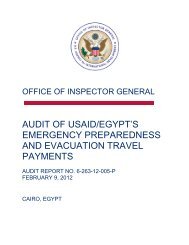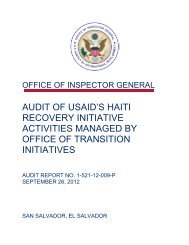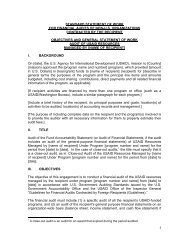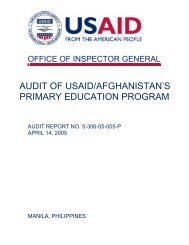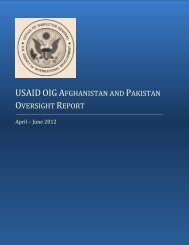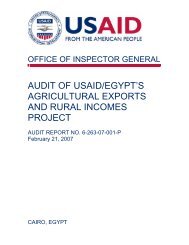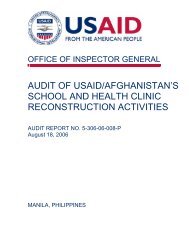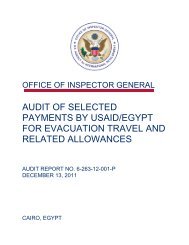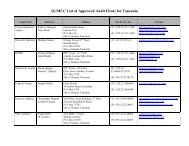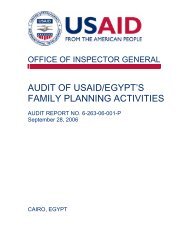The partial implementation occurred because <strong>USAID</strong> did not embrace PM2A from the start ormake sure it was implemented fully, although all three cooperating sponsors had included it intheir proposals and the 2009 technical guidance promoted it.CRS reported the pilot approach for implementing PM2A in its 2009 “Pipeline and ResourceEstimate Proposal,” 12 but did not specify in this document—or any subsequent reporting—whereand to what extent it was implementing PM2A. The <strong>Title</strong> <strong>II</strong> activity manager in Haiti thought thatCRS had implemented PM2A at least to some degree in most <strong>of</strong> the target areas. However, as<strong>of</strong> December 2011, CRS had implemented the program in just half <strong>of</strong> them. In addition, asmentioned above, CRS lacked sufficient resources for implementing PM2A and continues toimplement it only partially. Had the method been fully embraced and rapidly implemented byboth ACDI/VOCA and CRS, malnutrition would likely have further decreased in their targetlocations.FFP’s announcement for the next <strong>Title</strong> <strong>II</strong> program in Haiti states that development partnersshould use PM2A, which is renamed the “first 1,000 days approach.” 13 To ensure that the nextMYAP fully implements this approach, we make the following recommendations.Recommendation 4. We recommend that Food for Peace and <strong>USAID</strong>/Haiti develop acost estimate for implementing the first 1,000 days approach for the next multiyearassistance program to make sure potential cooperating sponsors incorporate sufficientresources in their budgets that demonstrate the capacity to fully implement theapproach.Recommendation 5. We recommend that <strong>USAID</strong>/Haiti include validation <strong>of</strong>implementation <strong>of</strong> the first 1,000 days approach in the monitoring plan for the nextmultiyear assistance program.Cooperating Partners Used IndicatorsThat Were Excessive, Duplicative, andNot Coordinated Across the ProgramAccording to ADS 200.6, performance indicators are used to observe progress and measureactual results compared with expected results. Performance indicators help answer how orwhether a <strong>USAID</strong> mission/<strong>of</strong>fice is progressing toward its objective. ADS 203.3.4.2 states that,among other things, good performance indicators should be:Objective, or unambiguous about what is being measured and precisely defined in theperformance management plan.Useful for management at the relevant level <strong>of</strong> decision making.Adequate or including only as many indicators as are necessary and cost-effective forresults management and reporting purposes.12 The pipeline and resource estimate proposal describes an awardee’s food aid resource needs andactivities for a food aid program over the course <strong>of</strong> the upcoming implementation year.13The country specific information for Haiti for fiscal year 2012 notes that the first 1,000 days approachwas previously referred to as “Preventing Malnutrition in Children Under Two Approach” (PM2A).9
Additionally, ADS 203.3.3.2 states that only information that is directly useful for performancemanagement should be collected and reported. More information is not necessarily betterbecause it markedly increases the management burden and cost to collect and analyze.The cooperating sponsors’ indicators did not comply fully with ADS standards. Although ADSstates that a minimum number <strong>of</strong> indicators should be chosen, World Vision is tracking73 indicators, CRS is tracking 63, and ACDI/VOCA is tracking 47. Mission <strong>of</strong>ficials andcooperating sponsors agreed that they were tracking too many indicators, for which all threesponsors said there is a large monitoring and reporting burden. In addition, some indicatorswere duplicative or irrelevant.The 2010 evaluation recommended reducing the number <strong>of</strong> output indicators that eachcooperating sponsor was required to tracked and increasing the number <strong>of</strong> outcome and impactindicators. The evaluation further stated that FFP and <strong>USAID</strong> require indicators that are similar,but different enough to require separate tracking and reporting, and that tracking all the datarequired is very costly. The evaluation suggested other indicators that were not being trackedbut should be. FANTA-2 also reported that the cooperating sponsors were not always trackinginformation that would help evaluate the <strong>Title</strong> <strong>II</strong> program. For instance, tracking thebeneficiaries who receive both MCHN and livelihood benefits could help FANTA-2 assess theimpact <strong>of</strong> integrating these activities.In addition, it is difficult to evaluate the overall program progress and results because theindicators vary among the cooperating sponsors. While there are differences in the sponsors’approaches, there are also many similarities that would lend themselves to more standardizedreporting. For instance, all three have a custom indicator to report the number <strong>of</strong> beneficiariesreceiving food rations, an important data point for several programmatic reasons. However,these cannot be summarized because each indicator defines beneficiaries differently: WorldVision includes four types <strong>of</strong> beneficiaries, CRS counts women receiving health services, andACDI/VOCA counts the number <strong>of</strong> pregnant and lactating mothers receiving food rations. 14World Vision. World Vision did not address the duplicative indicators mentioned in theevaluation, and they remain in the indicator tracking tables. In addition, World Vision added 16new indicators in 2011 (none <strong>of</strong> which were recommended by the evaluation team), continues toinclude indicators in its annual report for which no achievements have been reported, andremoved 3 from the tracking tables without explanation to <strong>USAID</strong>.CRS. CRS also did not address the duplicative indicators mentioned in the evaluation, and theyremain in the tracking tables. CRS has yet to report on “number <strong>of</strong> people with increasedeconomic benefits derived from sustainable natural resource management and conservation asa result <strong>of</strong> USG assistance,” which CRS <strong>of</strong>ficials said was never formalized and put into themonitoring and evaluation system. The mission never agreed on a methodology formeasurement, and therefore the indicator was not included in the baseline. CRS agreed thatthe information for the indicator would be collected for the final evaluation.ACDI/VOCA. ACDI/VOCA was the only cooperating sponsor that addressed the evaluation’sindicator comments directly. Of the three cooperating sponsors, it is reporting on the fewest14An additional example is the indicator for the number <strong>of</strong> savings groups, which each sponsor definesdifferently. ACDI/VOCA is measuring “number established”; CRS, “number assisted”; and WorldVision, “number trained and monitored.”10



